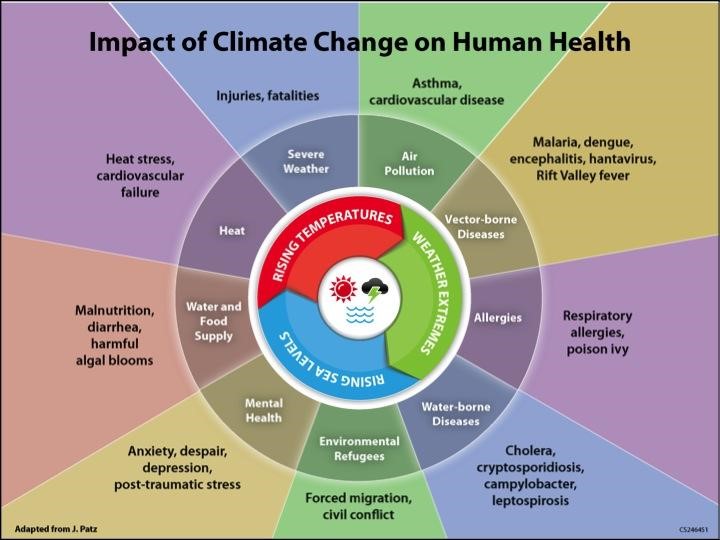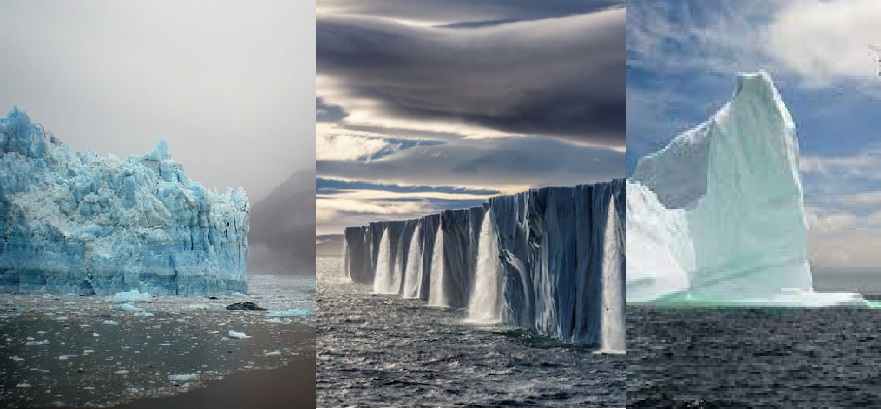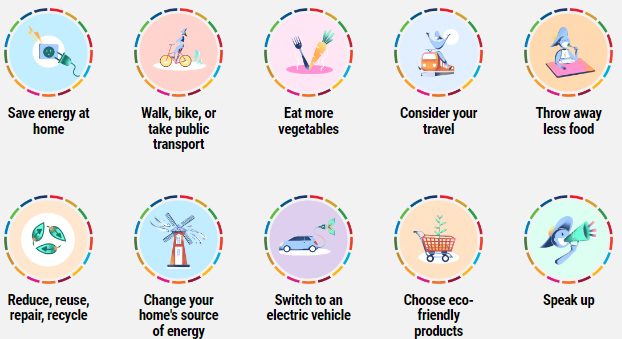Climate refers to the weather condition of a particular place over a given period of time. Climate consists of all the climatic elements such as rainfall, precipitation, snow patterns, temperature, sunshine, and relative humidity (United Nations Framework Convention on Climate Change (UNFCCC) (2006). As human activities such as deforestation, mining, burning of fossil fuels, the emission of toxic gasses and smokes from households and industries intensifies in the atmosphere couple with the high accumulation of other environmental pollutants, the concentration of the green house gases such as methane, ozone, and CO2 increases, this bring about the alteration in the normal occurrence of the climatic elements. With time, this alterations causes Global Warming and climate change (World Meteorological Organization (WMO), (2021a;2022).
According to the report of the European Environment Agency (EEA) (2008), there has been a frequent occurrence of extreme weather events, a continual rise in the global sea level since 1961 up to about 1.8mm per year.
Climate change is linked with the persistence of many infectious diseases as it directly affect human health. The transmission of infectious disease owing to climate change can be more threatening than the world has ever thought of, if nothing is been done. For every disease transmission, three components are involved. These are; the pathogen it self, the vector or the host, and the environment. For a number of pathogens, intermediate hosts or vectors are required for the completion of their lifecycle. However, climate as well as weather conditions are required for the growth and distribution of pathogens, the diseas vectors and the hosts (Intergovernmental Panel on Climate Change) (IPCC, 2012). As these three components are dependent on weather conditions, changes in these conditions may as well have a direct impact in the occurrence of these diseases.
Several research findings have discovered the interlinking pattern of increase in earth temperature and how it favours the spread of infectious diseases as well as geographic expansion of these diseases as seen in Figure 1. Overall, the spread and seasonal distributions of infectious diseases is been affected by climate and geographical conditions which also affects the intensity of infectious diseases.
Infectious diseases especially those transmitted by insects vectors (fleas, bed bugs, lice, mosquitoes) and ticks are quite very sensitive to changing climatic conditions and this immensely contribute in the transmission of infectious diseases such as those caused by viruses (dengue fever caused by infections with dengue virus, chikungunya virus, hantavirus, yellow fever), parasites (filariasis, leshmaniasis, sleeping sickness, Malaria) and bacteria (plague, salmonellosis, shigellosis, cholera, lyme disease e.t.c.) (Jofre et al., 2010; Bozic and Kanduc, 2021).

Figure 1: Human infectious diseases transmission and the Impact of Global Climate change (Leo et al., 2020).
As the temperature increases, it might influences the life cycle, growth as well as the overall survival rate of pathogens or by indirectly affecting the pathogens via changes in the environment, the ecological characteristics or specific competitors of that pathogen in question. At a long run, this may alters the normal disease distribution. For example, the Japanese Encephalitis Virus (JEV), which is a virus that infects the brain cells and is passed to mosquitoes as they bite birds and pigs to which the virus resides, and eventually transmit to humans following mosquito bites. This two different diseases, malaria and JEV has has a unique characteristics as mosquito development requires a temperature of 22–23 °C while JEV transmission requires a minimum temperature of 25–26°C (WMO, 2022).
As the temperature exceeds 33°–39 °C, the development of the parasite (Plasmodium vivax and Plasmodium falciparum) ceases, leading to a stop in its entire life cycle. Moreso, as the pathogen extrinsic incubation period (EIP) become altered, this may favoured the organism by making rapid the incubation period via reduction in the number of days. For example, the malaria parasite P. falciparum has a normal EIP of 26 days at 20 °C, but as the temperature becomes elevated to about 25 °C, the normal EIP becomes distorted by shortening down to 13 days (Wu et al., 2016). On the other hand, lower temperature has a higher chances in prolonging a pathogens EIP and in turn, reduces the rate of disease transmission. This can be seen in dengue fever (viral illness) as only limited number of mosquito parasites may survive such a lower and unfavourable condition.
In addition, elevated temperature in especially hot weather period may lead to an increase in room temperature which may eventually increases the temperature of food storage environment, water bodies as well as the normal body temperature of man and animals. This provide a conducive environment for the growth (multiplication) of many pathogenic microorganisms. Moreso, this temperature increase following change in climatic elements can bring about the melting of glaciers (Figure 2), which make the water bodies exceeds their carrying capacity and eventually leads to flooding. Flooding is linked with the occurrence of many food borne pathogens, mainly because as the run off water washes over suckaways, as well as human and animal feaces as a result of open defication and eventually contaminate public water bodies, the openly air dried cereals as seen in major Nigerian and other African roads, as well as ready to eat fruits and vegetables in farms, markets and other storage environment (Jofre et al., 2010).
Changes in humidity levels has also been observed to play a significant role in the transmission of air borne pathogens such as Influenza, measles, Mumps, Whooping cough (pertussis)and Chickenpox e.t.c. These pathogens are responsive to some humidity conditions mainly the temperature as well as the absolute humidity.

Figure 2: description of the melting of an ice cap following the increase in the global temperature as a result of climate change .
The control of climate change is everyone responsibility. More so, the use of Early Warning Systems (EWS) which comprises of risk knowledge, monitoring and warning services, dissemination and communication and finallyresponse capability, will go a long in tracking as well as the control of climate change.

Figure 3: Solution to global climate change “Our collective efforts counts” (UN Campaign for Individual Action, 2022).
According to the 2022 reports of the United Nations Campaign for Individual Action on climate change and sustainability, some ten Healthy environmental practices (Figure 3) will significantly contribute in solving the problems of global climate change. These are; Save energy at home, Walk, bike, or take public transport, Eat more vegetables, Consider your travel, Throw away less food, Reduce, reuse, repair & recycle, Change your home’s source of energy, Switch to an electric vehicle, Choose eco-friendly products and lastly Speak up. Until we adopt these changes, the evil effect of climate change attached with the threat posed by many infectious diseases will be averted.
References
- Wu, X., Lu, Y., Zhou, S., Chen, L. and Xu, B. (2016). Impact of climate change on human infectious diseases: Empirical evidence and human adaptation. Environment International 86; 14–23
- European Environment Agency (EEA), (2008). Impact of Europe’s Changing Climate—2008 Indicator-based Assessment. Joint EEA-JRC-WHO report. European Environment Agency, Copenhagen
- Intergovernmental Panel on Climate Change (IPCC), 2012. Managing the Risks of Extreme Events and Disasters to Advance Climate Change Adaptation. In: Field, C.B., Barros, V., Stocker, T.F., Qin, D., Dokken, D.J., Ebi, K.L., Mastrandrea, M.D., Mach, K.J., Plattner, G.-K., Allen, S.K., Tignor, M., Midgley, P.M. (Eds.), A Special Report of Working Groups I and II of the Intergovernmental Panel on Climate Change. Cambridge University Press, Cambridge, UK, and New York, USA.
- United Nations Framework Convention on Climate Change (UNFCCC). (2006). Handbook. Bonn, Germany: Climate Change Secretariat. Produced by Intergovernmental and Legal Affairs, Climate Change Secretariat
- World Meteorological Organization (WMO), (2021a). State of the climate in Africa 2020. WMO No. 1275
- World Meteorological Organization (WMO) in collaboration with United Nation Environment Programmeme (UNEP). Climate Change (2022). Impacts, Adaptations and Vulnerability, Summary for Policy Makers. Working gropup II contribution to the Sixth Assessment Report of the Intergovernmental Panel on Climate Change. Alisa Singer, www.environmentalgraphiti.org © 2022 All rights reserved. Source: IPCC.
- World Meteorological Organization (WMO). (2021b). State of Climate in 2021: Extreme events and major impacts. Geneva, 31 October 2021 (WMO) – Record atmospheric greenhouse gas concentrations and associated accumulated heat have propelled the planet into uncharted territory, with far-reaching repercussions for current and future generations.
- Jofre, J., Blanch, A.R. and Lucena, F. (2010).Waterborne infectious disease outbreaks associated with water scarcity and rainfall events. In:Sabater, S., Barcelo, D. (Eds.), Water Scarcity in the Mediterranean: Perspectives under Global Change. Springer.
- Bozic, A. and Kanduc, M. (2021). Relative humidity in droplet and airborne transmission of disease. J Biol Phys.47(1):1-29. doi: 10.1007/s10867-020-09562-5
- Leo, G. A. D., Sokolow, H., Eliézer, K. N. G., Chamberlin, A. J., Yang, G., Utzinger, J. (2020). Effect of changing climates and human activity on schistosomiasis transmission and potential solutions to contain its Spread. BMJ2020; 371 doi: https://doi.org/10.1136/bmj.m4324 https://www.un.org/en/actnow/ten-actions#unplug (Published 16 November 2020)
- The UN Campaign for Individual Action. ActNow is the United Nations campaign for individual action on climate change and sustainability. Accessed on 6th, June, 2022. https://www.un.org/en/actnow
Ismail Rabiu, is an Assistant Lecturer in the Department of Microbiology, School of Science and Information Technology, Skyline University Nigeria. He holds an M.Sc in Medical Microbiology with a specialization in Pharmaceutical Microbiology and Infectious diseases.
You can join the conversation on Facebook @SkylineUniversityNG and on Twitter @SkylineUNigeria
